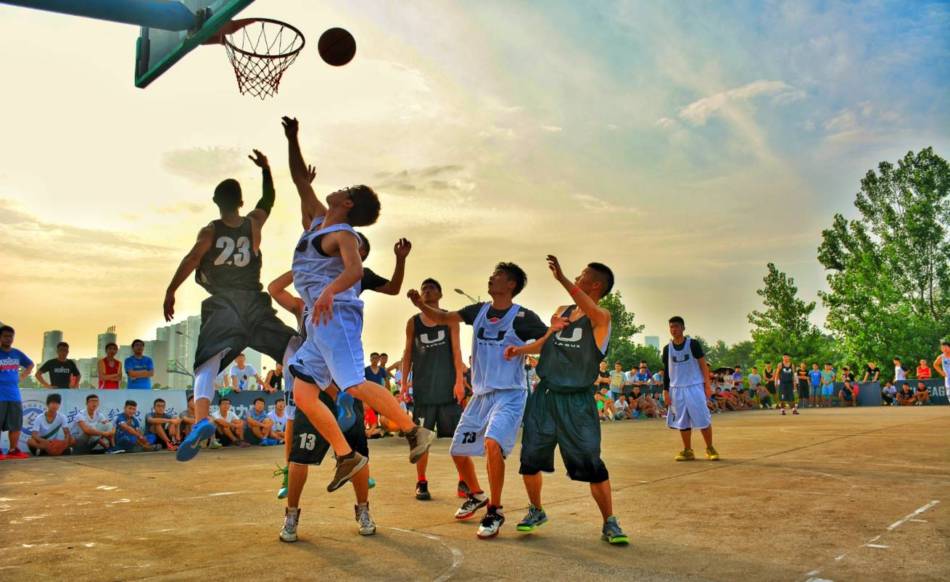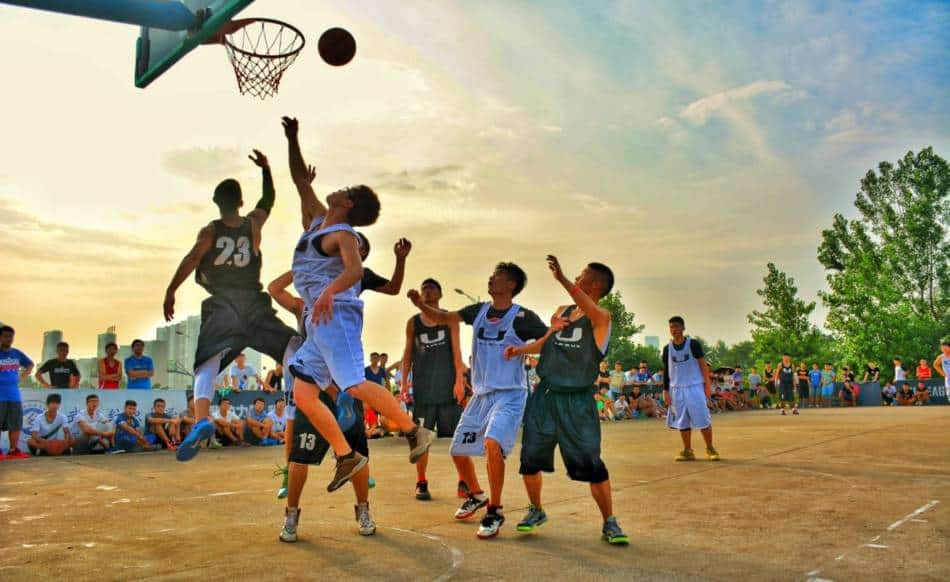
Everyone knows that basketball is a game played between two teams, but most people don’t know how many players make up each team. While it differs depending on the league you’re playing in, basketball team rosters must stay under a certain number of players.
So, how many players are on a basketball team?
Most basketball teams consist of 12-15 players. There are always five players on the court at one time for each team, with the rest either sitting on the bench or listed as a healthy scratch. While superstars get a majority of the money and attention, having a deep roster is very important.
Building a roster isn’t easy. There are a wide range of rules, guidelines, exceptions, and requirements involved, which makes building a roster challenging for basketball general managers and head coaches.
Since this can be confusing for newcomers to the game, let’s go over everything you need to know about roster sizes in basketball.
What Is the Active Roster in Basketball?
Just because a basketball team has 12-15 players on the roster doesn’t mean all of them play. Some of those players only see a few minutes of action all season long. Ultimately, it’s the difference between being listed on the active roster and being listed as a healthy scratch.
In basketball, the active roster consists of the players available to play each game — usually no more than 13. Players on the active roster fall into one of five categories — superstars, starters, sixth man, role players, or bench players.
The number of minutes they receive each night depends on which category they fall into.
While making the active roster is every player’s dream, it doesn’t mean you’re guaranteed minutes. Many players that fall in the ‘bench player’ category won’t see time on the court.
There are generally two players of this nature, no matter which league you’re in. At the end of the day, head coaches have the final say on who plays and how long they play for.
Since the active roster is what teams roll with on game day, these players are the most important players at any given time. They must understand the game plan and their roles, and execute when called upon.
Whether they’re a superstar or bench player, coaches need 110% every time they step foot on the court.
What Is a Healthy Scratch in Basketball?
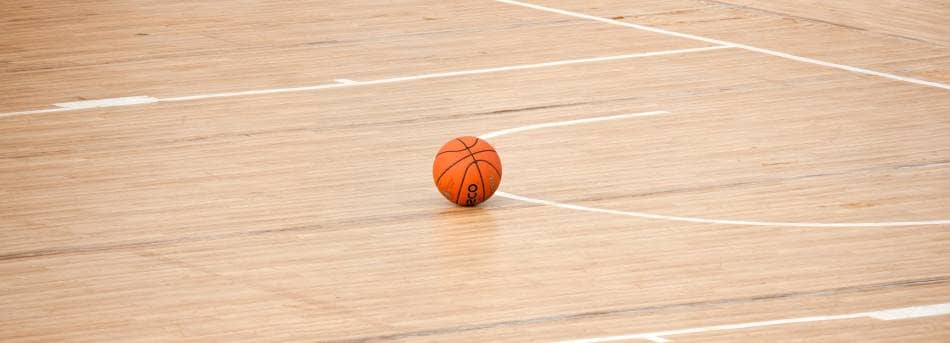
Being listed as a healthy scratch is less-desirable than landing on the active roster, but it’s still a step in the right direction for any young player — unless you’re demoted to the role.
The good news is you’re still on the team roster and are the next man up when someone is either injured or underperforming.
Healthy scratches are considered part of a team’s inactive list, which also consists of injured players that can’t play. While injured players must wait for the ‘okay’ from a team doctor, head coaches can call up a healthy scratch at any time during the season.
Most teams reserve these roster spots for a proven veteran that acts more like a coach’s assistant.
A good example of this is Udonis Haslem of the Miami Heat. He’s entering his 18th season since being drafted by the team in 2003. He has spent a majority of the past five seasons as a healthy scratch.
His main responsibility on the team is molding teammates like Bam Adebayo, Chris Silva, and Precious Achiuwa.
The other type of player that’s often listed as a healthy scratch is the young, unproven player. These players are more common because they’re more valuable and have a higher ceiling when a replacement player is needed mid-season.
Whether they’re a veteran or young player, healthy scratches play an important role in a team’s success year-round.
How Many Players Are On the Court in Basketball?
Much like any other sport, teams are limited to a certain number of players on the court at one time.
When basketball was originally invented, there were a total of 18 players on the court — nine for each team. James Naismith chose this number because there were 18 children in his class when he invented the game of basketball.
Today, the limit is five players on the court for each team. That means there are a total of ten players on the court at one time during a live game. Teams with more than five players on the court at any time are assessed a technical foul, resulting in one free throw for the opposing team.
The five players on the court at the start of the game are considered the ‘starters.’ The more ‘superstars’ you have in your starting lineup, the better.
Either way, teamwork is highly important in basketball and head coaches must ensure their roster works well together — especially their starting lineup.
At any time during a game, a head coach can turn to his bench and substitute a player into the game. This gives the starters some rest and allows a head coach to keep certain players ready for certain moments.
In some dire situations, such as multiple injuries, teams are left with less than five active players during a game. Teams can continue playing but are at an obvious disadvantage to the opposing team. A good example of this happened in 2010 with the Golden State Warriors.
They needed eight dressed players to start the game but only had six healthy players. To hit their minimum, they dressed two of their injured players with no plans of playing them at all.
During their game, however, one of their healthy players suffered an injury.
They were down to five healthy players the rest of the game until one of them fouled out. Down to four healthy players, the refs forced the Warriors to send in their injured players, which they did.
The Warriors ended up winning the game in incredible fashion, but it was an awkward situation for everyone involved.
How Many Players Sit on the Bench in Basketball?
With five players on the basketball court at all times, that leaves no more than eight players on the bench at any one time — no more than 13 on an active roster.
The actual number of players on the bench depends on how many players are injured and how many total players the head coach has on their team.
Any player sitting on the bench must be ready to enter the game, especially since no one knows how a game will turn out.
Injuries happen more often than we’d like, players foul out often, and everyone needs a rest at some point. A deep roster puts your team at an advantage no matter what happens.
When setting up your roster, it’s important to make sure each bench player has a role — whether or not you plan on giving them frequent minutes.
Better yet, it’s imperative each bench player understands that role and fulfills it when they step out onto the basketball court. It takes an entire team to win a basketball game, not just a solid performance from the starters.
The Importance of Bench Players in the NBA
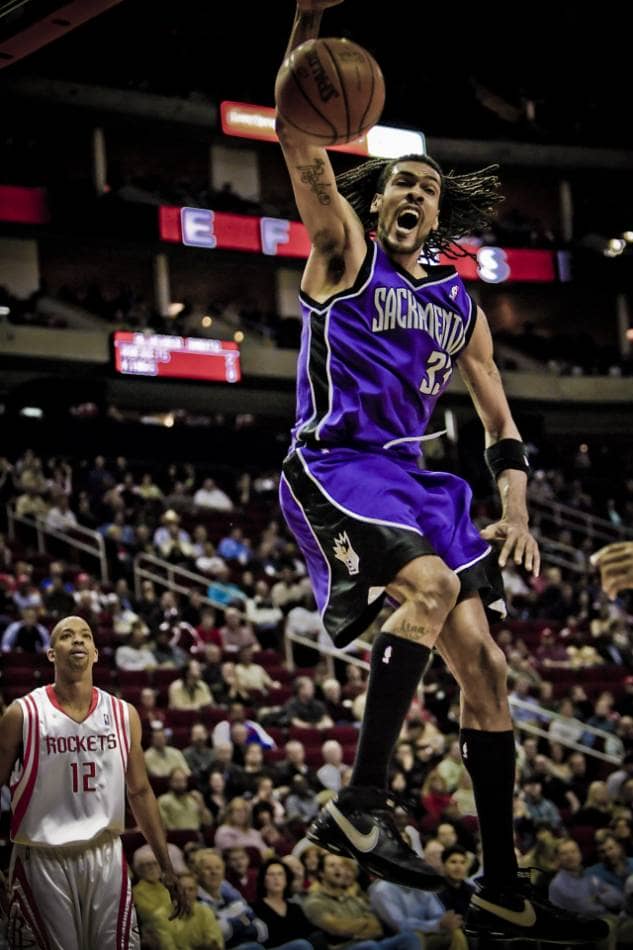
In many aspects, a bench is just as important as the starting lineup. They don’t play as often as the starters and they don’t receive the same amount of attention each NBA game, but the minutes they play are crucial when establishing or maintaining a lead.
They don’t just give your starters a moment of rest, but they lift your entire team in the process. A good bench puts points on the scoreboard and plays a strict brand of defense.
If your team is behind, they can cut down the lead or erase it completely. If your team is already ahead, they can help you pad the lead.
When looking at your bench, there are a variety of player types and roles they maintain. The most exclusive role on the bench is the sixth man — the first player off the bench.
These players are generally good enough to start but are saved so the team has consistency and reliability coming off the bench.
Beyond that, some players are viewed more as an offensive piece, while others are utilized for their defensive prowess. Either way, these role-players enter the game strategically and sometimes not at all.
This is where being extremely talented in one area can help your team. For example, head coaches generally roll with their best three-point shooters when points are needed late in the game.
Without a reliable bench, teams can quickly fall behind the opposing team. These teams can have solid first quarters, but disadvantages start presenting themselves as games go on.
Before you know it, these teams dig themselves into a hole they can’t get out of and must fight their way back the rest of the game.
How Many Substitutions Are Allowed in Basketball?
In basketball, teams are allowed to substitute as many times as they want or need. Instead of limiting the number of times, head coaches are limited on when they can substitute.
For example, substitutions are only allowed during a dead ball when the clock stops.
A few things must happen before a substitution enters the game. First, they must report to the scorer’s table.
When a dead ball occurs and the clock stops, the referee must whistle the player in and give the player being replaced an opportunity to exit. This happens rather quickly in real-time.
Beyond that, the NBA has a wide range of other rules that must be met — some of them more specific than what’s listed above.
Let’s take a look at how the NBA handles substitutions:
- The player must approach the 8’ Substitution Box, check-in with the attendant at the scorer’s table, and notify them who they’re replacing.
- The player must remain in the vicinity of the 8’ Substitution Box until called in by the referee.
- Players must be ready to go when called in by the referee. That means no delays, removing clothing, or tying shoes once called in.
- Players can’t replace a free throw shooter or someone taking a jump ball unless an ejection occurred.
- Once called in, a player can’t be replaced until a player legally touches the ball during play, the ref calls a personal or technical foul, there’s a change in possession or a team takes a timeout.
- Players can be removed from the scorer’s table before being called in, but not during or after.
- Players can return to the game after being subbed out during the same dead ball.
- If players aren’t in the vicinity of the scorer’s table at the time of a violation, they must wait until the next substitution opportunity.
- During free throws, teams must wait for the final free throw before substituting any players.
- Teams can’t substitute after a field goal unless a foul or timeout is called.
- If the officials suspend play for any reason, teams are not allowed to substitute.
- Once disqualified, a player cannot return to the game.
Much like the game plan itself, substituting during a live basketball game is one of the major reasons coaches get paid ‘the big bucks’ on the staff.
They must make extremely important decisions in real-time when setting their team up for success. Strategic substitutions are just as crucial as the game plan itself.
How Many Players Are On an NBA Team?
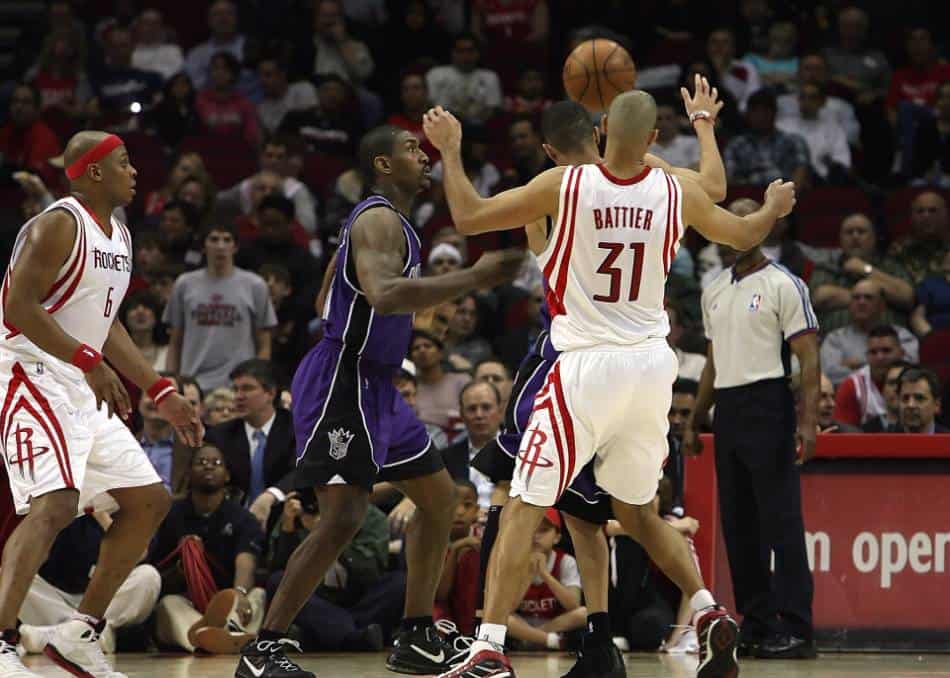
We’ve mentioned a majority of the basics when it comes to NBA basketball team rosters, but we haven’t mentioned the specifics when looking at the different basketball leagues across the world.
In the NBA, teams are allowed a maximum of 15 players and a minimum of 14 players under contract. This differs from the active roster, which must have 12 or 13 active players — a minimum of eight suit up.
It also differs from the number of players allowed during the offseason, which is 20 players per basketball team.
Once the NBA season starts, the maximum and minimum roster sizes take effect. There are a few exceptions and instances where a basketball team might dip above or below these numbers.
Let’s take a look at some of these below:
- Teams are allowed 16 players if there are more than four players seriously injured at any given time. Once a player returns from injury, they must return to a 15-player roster. This is known as the ‘hardship exception.’
- Teams are allowed 16 players if one of their players is suspended. For a 4-game or 5-game suspension, the basketball team can add a player following the 3rd game of the suspension. For any suspension lasting 6 or more games, the basketball team must wait until after the 5th game when signing an extra player.
- Teams are allowed 12 or 13 players in rare circumstances. Anytime a basketball team dips below the 14-player minimum, the league must approve it and they must return to the 14-player minimum within two weeks.
In addition to allowing 15 NBA players per basketball team, head coaches are allowed up to two two-way contracts. These are generally given to G League players on the cusp of becoming an NBA role player.
When signing someone to a two-way contract, they can only play up to 50 games. The good news is they don’t need to be consecutive and can happen strategically.
How Many Players Are On a FIBA Basketball Team?
There’s nothing more exciting than FIBA (International) basketball. It’s where players wear their country’s colors proudly, no matter where they’re from.
For the United States, it means bringing a majority of the greatest players in the game together on the same basketball team. It’s what makes our country so dominant in FIBA play.
When building a roster for FIBA games, each country is allowed 12 players — which is two players less than the minimum for NBA.
When you consider how many superstars and elite players the United States is choosing from every four years, there are plenty that don’t make the final cut.
Of the 12 players, FIBA teams can have one naturalized player per roster. These players weren’t always a citizen of the country but acquired citizenship over time.
Let’s take a look at Team USA’s roster for the 2019 FIBA Basketball World Cup:
- Derrick White
- Donovan Mitchell
- Joe Harris
- Marcus Smart
- Harrison Barnes
- Jaylen Brown
- Jayson Tatum
- Mason Plumlee
- Myles Turner
- Brook Lopez
- Khris Middleton
- Kemba Walker
The Head Coach of Team USA is Gregg Popovich. His assistant coaches are Steve Kerr, Lloyd Pierce, and Jay Wright.
They finished 6-2 in the 2019 FIBA Basketball World Cup and 7th in the standings, earning a ticket to the 2020(2021) Olympics in Tokyo.
How Many Players Are On a College Basketball Team?
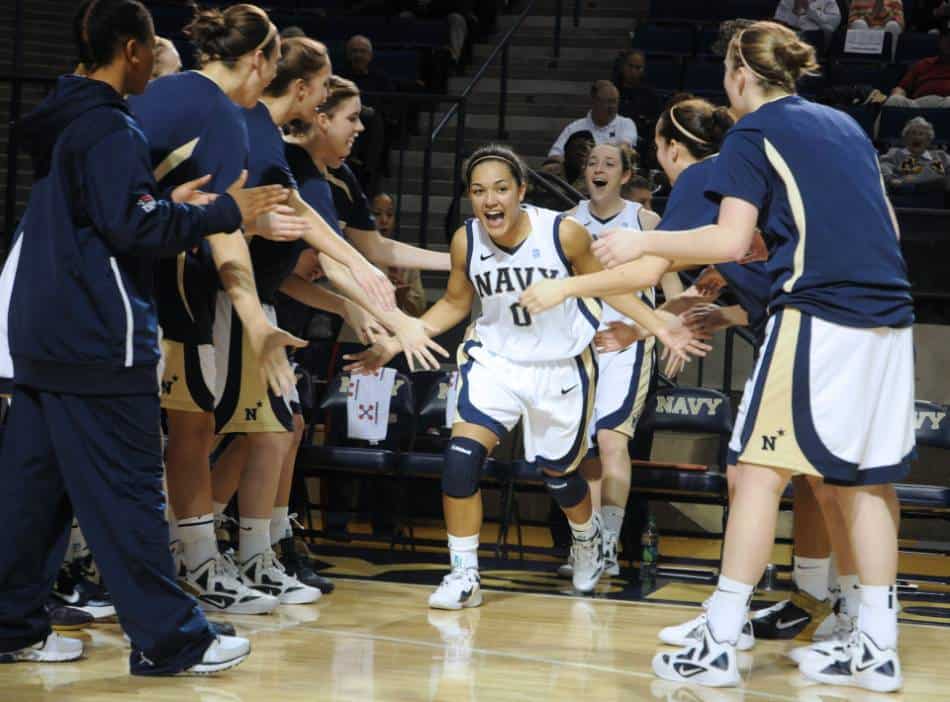
College teams are extremely similar to NBA teams, especially since they’re allowed up to 15 players on the roster at any point in time.
The major difference is that college teams must have 13 players suit up each basketball game — whereas the NBA allows teams 12 or 13 players.
The two players that don’t suit up are allowed to sit behind the bench, but this often turns into an issue during away games.
Some colleges and universities don’t have a lot of money to spend on travel — unlike colleges like Duke, North Carolina, Kentucky, Kansas, etc.
When budgeting, these other less-fortunate teams often decide against traveling with the two inactive players, also known as healthy scratches.
They are, however, almost always at home games and are available to suit up when replacing a player on the active roster.
How Many Players Are On a High School Basketball Team?
The number of players on a high school basketball team varies greatly on the high school itself. Varsity and junior varsity teams across the nation set limitations for roster sizes and it largely has to do with the amount of interest from students.
Most high school basketball teams can’t roster more than 15 students at one time, with 12 oftentimes being the minimum. Many schools have high turnouts when making the final cuts and elect to have multiple teams.
Since these additional teams aren’t part of the actual school’s conference, it’s often an added expense for the school.
In some instances, you see high schools with more than 15 basketball players. While allowed in some areas, it’s extremely difficult to give every student proper minutes and often takes away from the students that deserve a lot of minutes each basketball game.
Do Players Play Multiple Positions in Basketball?
On the basketball court, players have positions they specialize in. Most players fall under one position or two positions, but the game is evolving and players are starting to specialize in all facets of the game.
This is true for basketball players like LeBron James, Kevin Durant, Giannis Antetokounmpo, and Ben Simmons.
At the end of the day, there are five positions on the basketball court and they each have their responsibility:
- Point Guard – the main ball handler and play-caller, the point guard is generally running the show. They’re often the smallest, but also the smartest.
- Shooting Guard – as the name suggests, the shooting guard specializes in shooting. They live on the three-point line and on the wing, but they also know how to defend.
- Small Forward – the small forward lives on the wing too, but they’re more built for driving and drawing bodies into the paint. They often open up space for the guards to work.
- Power Forward – in traditional basketball, the power forward was more of a down-low big man. That’s still the case today, but they’ve added an outside element that makes them versatile.
- Center – the centers are the basketball players tasked with protecting the rim at all times. They’re starting to work on their shooting, but they spend most of their time down low.
The more versatile you are as a player, the more valuable you are to your basketball team. Head coaches love that in a player and it’s an excellent way of getting noticed at any level.
That’s why players must always work on improving their basketball game and strengthening their various weaknesses time and again.
